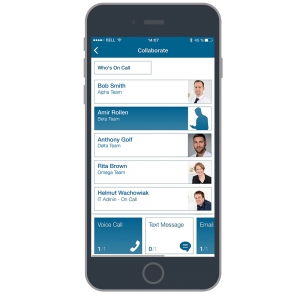
When we introduced ‘remote actions’ in 2012, i.e. the execution of IT automation tasks from your smartphone, we aimed at empowering the mobile (IT) workforce of the future.
We aimed at relieving IT people from being bound to their desks, notebooks and PCs. Through our mobile app for iPhone and Android, IT incident responders were enabled to literally work from anywhere and to respond to critical IT incidents even from the football stadium, ultimately leading to a 60% faster incident resolution.
“IT engineers on call can literally troubleshoot and remedy problems while in a football stadium. The overall incident response became 24/7 real-time, ensuring a continuous availability of mission – critical IT infrastructure and applications.”
Gerrit Grote, IT Infrastructure Administrator at CBR Fashion Group
Since 2012 we have added an abundance of features to our mobile app, turning our leading incident management and response platform into the most powerful and most flexible toolbox for responding and resolving critical incidents for IT, IoT, manufacturing, utilites operations.
And from the very start we wanted to go beyond sending mobile alerts and enabling acknowledgement ‘only’. We targeted a much more powerful solution.
The ‘standard’ in mobile incident management
 We of course implemented typical alert incident management capabilities like
We of course implemented typical alert incident management capabilities like
- acknowledging alerts on-the-go
- sharing incident details
- annotating incidents
- single-tap phone bridges and conferences
- real-time access to ‘who-is-on-call’ information
- schedules overwrites (‘stand-ins’)
And we saw this as a must-have for a serious mobile incident management application.
So, we technically based it on 2-way integrations with ITSM and ITOM tools for instance, leading to real-time updates and synching of alert status between our mobile app and 3rd party applications. If for instance a ServiceNow incident is acknowledged through our mobile app, the ownership and status is updated in ServiceNow in real-time. And vice versa, if an incident is closed in ServiceNow, all notifications are stopped in Enterprise Alert and the relating alert is set to closed, too.
Enablement of real-time mobile IT operations has been a core task for Enterprise Alert from the very start.
Beyond simply Responding – Unleashing Remote Troubleshooting and Remediation
We were and are convinced that alert management should not stop at acknowledging an alert and taking ownership. Hence we introduced the meanwhile ‘famous’ remote actions back in 2012 and improved it ever since.
Connecting IT automation tools like System Center Orchestrator, Micro Focus (HP) Operations Orchestration, ServiceNow and other tools to Enterprise Alert, we enable IT admins to initiate and execute ANY(!) IT automation task right from the smartphone. In its capabilities it is second to none in the market. The power and flexibility of this Enterprise Alert feature is unmatched.
On top, Enterprise Alert provides the ability to host scripts (e.g. JScripts) that take parameters and can be executed with a single-tap from our mobile app, either directly from the dashboard or from within the context of a specific alert. This unleashes an incredible ‘remote power’ to troubleshoot and remediate IT or any other incident, enabling even to restart machines on the shop floor. Needless to say, that we implemented it in a highly secure way including provision models, access rights, etc
Another smart implementation is that Enterprises Alert re-uses values of the original 3rd party event/alert and injects those into the play- and runbooks. That means that if an alert comes in relating to server ‘ABC’, the hostname is injected into the runbook that restart any server, meaning you just need one runbook for all servers as the hostname comes from the original event. This reduces the number of automation runbooks by prepopulating the needed values.
But there is even more. With all those remote actions, the Enterprise Alert mobile app digests user input. So, when you create a ‘remote action’ in Enterprise Alert you define the parameters it takes. When executed on the smartphone, the app renders a form taking user input, e.g. from a text field or dropdown list. These values are then injected into the related remote action. Thus, you can even query a database or do other fancy ‘remote stuff’.
This indeed hands genuine remote power to the mobile IT admin. Read here how this provides entirely new 24/7 operations experience.
Get to know the inventor and pacemaker of true mobile incident handling and resolution
If you want to explore how Enterprise Alert can mobilize your IT people, please request your personal demo.


